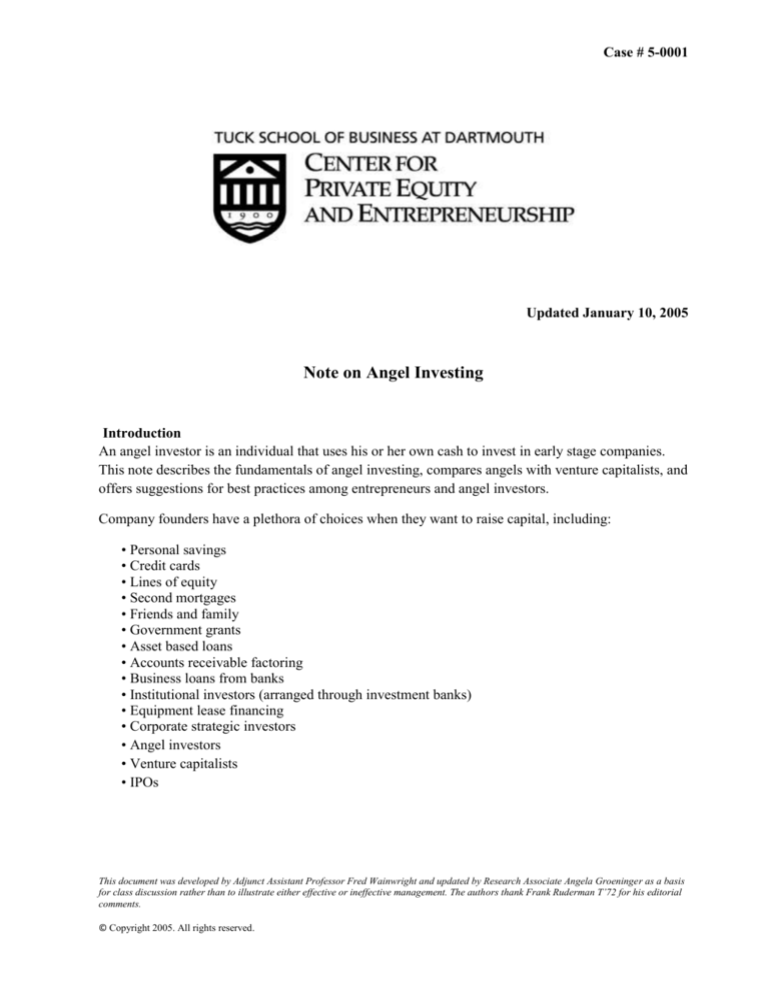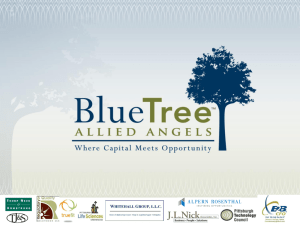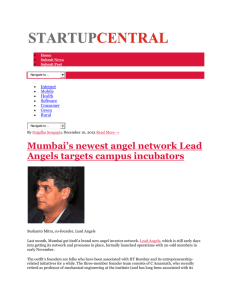
Case # 5-0001
Updated January 10, 2005
Note on Angel Investing
Introduction
An angel investor is an individual that uses his or her own cash to invest in early stage companies.
This note describes the fundamentals of angel investing, compares angels with venture capitalists, and
offers suggestions for best practices among entrepreneurs and angel investors.
Company founders have a plethora of choices when they want to raise capital, including:
• Personal savings
• Credit cards
• Lines of equity
• Second mortgages
• Friends and family
• Government grants
• Asset based loans
• Accounts receivable factoring
• Business loans from banks
• Institutional investors (arranged through investment banks)
• Equipment lease financing
• Corporate strategic investors
• Angel investors
• Venture capitalists
• IPOs
This document was developed by Adjunct Assistant Professor Fred Wainwright and updated by Research Associate Angela Groeninger as a basis
for class discussion rather than to illustrate either effective or ineffective management. The authors thank Frank Ruderman T’72 for his editorial
comments.
© Copyright 2005. All rights reserved.
Seedstage entrepreneurs, with very early stage concepts, products and companies, should weigh
their options carefully in order to ensure the long term survival and optimal growth path of their
startups. Founders can seek debt and/or equity investments. Debt-related capital most often
requires monthly payments that can reduce the cash flow of a fast growing company. Some
founders may ask for more equity capital than they really need and give up too much equity in
exchange.
Bill Gates, for example, still owns a substantial portion of Microsoft, whereas most founders see
their percentage ownership diluted to less than 5% after numerous rounds of financing and public
stock offerings. Fortunately, if the company has reached an IPO stage, the small slice of a very
big pie allows those founders to achieve a multi-million dollar net worth.
Angel investors are so named because in the early 1900s wealthy individuals provided capital to
help launch new theatrical productions. As patrons of the arts, these investors were considered by
theater professionals as “angels.” Estimates of the number of active angel investors in the US
vary widely because there are no registration requirements. The SEC Rule 501 states that an
“accredited investor” is a person with a net worth of at least $1 million or annual income of at
least $200,000 in the most recent two years or combined income with a spouse of $300,000
during those years. According to Forrester consulting, the number of households in the US that fit
that profile is approximately 630,000. The power of angels lies in the sheer number of companies
they fund. Some studies suggest angels invest in 10 to 20 times more companies than VCs.
Angels fill a critical capital gap, between “friends and family” and VCs. When a startup requires
more than $25,000 but less than about $1.5 million, angels are a viable source of capital. This
level of funding is below the radar screen of most venture capitalists, although some VCs will
occasionally fund a seed round of as little as $500,000. Angels usually invest using preferred
stock, which offers the owner more rights than common stock, and typically acquire 20-30% of a
company in the first round of financing. They like to make a return of 5 to 10 times their initial
investment in order to achieve a return on their own portfolio of between three and five times
their investment.
Why don’t angels simply invest in VC funds? According to the European Private Equity and
Venture Capital Association, in the past 10 years European VCs have produced a 14% return to
their investors. In the same period, according to the National Venture Capital Association, VC’s
in the US have produced a return of 26%. Angels, though, are not just driven by returns. They
typically fund a venture in its seed or startup stages, and if the business survives, subsequent
rounds are often provided by venture capital firms. Despite the illiquidity and risk involved in
this type of investing, angels believe the benefits of unlimited upside potential and the experience
of building a business far outweigh the costs. They have a strong emotional stake in investing and
enjoy coaching others and the rush of fast-paced company growth.
During the past few decades, VCs have raised larger and larger pools of capital and since the time and
expense of reviewing and funding a company are the same, regardless of
2
size, it is far more efficient for VCs to fund larger transactions. It is important that angels continue to be
actively involved in investing because without seed stage financing, the country’s entrepreneurial force
loses its energy.
Angels and VCs rarely compete for the same deals
Table 1 below compares and contrasts these two types of investors:
Table 1 – Angels vs. VCs
VCs
Funding amounts
Motivation to invest
Accessibility
$25,000 to $1.5 million
Not just return driven, strong
emotional component (“bragging
rights”, psychological benefits of
coaching, rush from being
involved in fast paced startups)
Prefer anonymity, reachable via
referrals or through angel groups
Geographical focus
Regional, within 4 hours drive
time
Key reasons to invest
Personal chemistry with
entrepreneur, detailed market
analysis, sustainable competitive
advantages
Less than VC firms because have
the luxury of being selective
Number of investments
Term sheet issuance
Relatively fast (one day to three
weeks), terms are somewhat
negotiable (more than with VCs)
Investment vehicle
Common or preferred stock,
occasionally convertible debt
(debt convertible to equity
shares)
10% - 30%
$250,000 to $10 million
Equity percentage
Typical post-money valuation of
startups*
Due diligence
Funding process
Long term value added
Relatively fast and light
Lump sum or milestone
Operational experience, common
sense advice, specific industry
expertise
Reaction to bad news
Roll up the sleeves and help
solve the problem, open up
rolodex
Target exit time
Target IRR returns
5 to 7 years
15% to 25%
$500,000 and above
Mostly return-driven with
adjustments for relationships with
other VCs and reputation among
entrepreneurs
Highly visible, usually will only
look at business plans referred by
their network of contacts
(attorneys, etc.)
Regional, national or
international, depending on the
firm
Nearly developed product,
operating history, strong and
experienced team, sustainable
competitive advantages
More than angels because need to
make a minimum number of
investments in a given year
Can be fast, but usually is at a
moderate pace (several weeks),
terms are fairly standard and not
very negotiable
Preferred stock (convertible to
common)
20% or more
$5 million and above
Relatively slow and methodical
Lump sum or milestone
Experience in managing growth,
deep pockets, networks of
additional sources of capital,
rolodex, experience in managing
IPOs and sale exits
Intense communication and
coaching; open up rolodex; help
structure joint ventures, new
financing rounds or mergers; fire
management
3 to 5 years
20% to 40%
3
* For a description of basic valuation concepts, see the valuation section below.
Angels have a variety of individual and professional backgrounds
Angels can add tremendous value to startups. On the other hand, angels are humans and are subject to
their personal idiosyncrasies. One or more of these characterizations may apply to an angel:
Guardian angel
This type of investor has relevant industry expertise and will be actively involved in helping the
startup achieve success. He or she has a strong rolodex of contacts and has the experience to add
substantial value as a board member.
Operational angel
This angel has significant experience as a senior executive in major corporations. For an
entrepreneur, this type of investor can add much value because he or she knows what the company
needs to do in order to scale up operations.
Entrepreneur angel
An investor that has “been there, done that” is very valuable to a novice entrepreneur. For example,
an entrepreneur can add perspective to the founders on what to expect from investors and how to
effectively negotiate financing terms.
Hands-off angel
A wealthy doctor, attorney or similar professional must focus on his or her day-to-day career. This
type of investor is willing to invest but usually does not have the time or specific expertise to be of
much help to the startup.
Control freak
Some investors either believe they have all the answers because they have achieved certain wealth or
they have the personality to convince themselves they know “everything.” Caveat emptor.
4
Lemming
Some angel investors will not make a decision unless an informal leader in the angel group invests or
makes positive comments about a startup. Success breeds success - even a term sheet from one or two
small investors can allow an entrepreneur to access larger investors, who usually become more interested
when they find out that fellow investors have committed. Some lemming investors are particularly astute
at leveraging the work of other investors whereas other lemmings simply trust blindly in the due diligence
and term sheets of fellow investors.
Angels band together
Angel investors increasingly join one or more informal or formal groups. There are various advantages of
working in groups:
• Social bonds and networking
• Access to pre-qualified deal flow
• Leverage intellectual capital and expertise of individual members
• Learn from each other regarding deal evaluation skills
• More extensive due diligence capability
• Alignment of members’ interests
Angel groups can be structured in various ways:
• Each member owns a portion of the legal entity representing the group
• Limited liability corporations are formed by individuals to invest in specific deals
• The group is a non-profit entity and individual angels invest independently
Names and contact information, if available, of angel groups in the West Coast and northern New England
are shown in Appendix 1.
Annual fees in angel groups are usually in the range of $100 to $2000 per member. These fees cover
meals, conference rooms and administrative staff.
Typically an entrepreneur must complete a questionnaire and submit an executive summary or a full
business plan. A proactive entrepreneur will understand the angel investing process. A reading list is
enclosed in Appendix 2 and a sample angel group questionnaire is shown in Appendix 3. Some groups
require that a member meet with the entrepreneur and determine if the plan is viable before allowing the
entrepreneur to present to the group. Other groups allow the administrative staff and managing director to
review the plan and invite the entrepreneur to present without a “champion.”
Once the presentation is made (usually in 10 to 45 minutes, including a question and answer period) the
entrepreneur is asked to leave the room. The angels discuss the opportunity and, if one or more angels are
interested then, depending on the group, either the entrepreneur is invited back at a later date for a more
thorough review of the plan or an initial term sheet is developed within a week and presented to the
entrepreneur.
5
Sometimes, if an entrepreneur presentation is weak but the idea has merits, the entrepreneur will be
coached on what to do in order to be able to present in a future meeting. Occasionally, the
entrepreneur is matched with an angel that is willing to coach the entrepreneur (informally or for a
fee) in order to raise the quality of the business to fundable status. Some angels specialize in helping
entrepreneurs write business plans and develop their strategy.
Angel groups occasionally band together with other angel groups to share due diligence and invest
sufficient capital to complete a round of financing.
Evaluation of business plans uses several parameters
Too many entrepreneurs limit their opportunities by writing weak business plans. Great ideas are
common; much rarer are businesses with the people and products to enter a market and take share or
dominate. Only 1 % to 2% of all business plans presented to angels or VCs receive funding.
Companies don’t build themselves. People build companies. Ultimately, an angel investor is selecting
a management team. A great team can make even a mediocre company achieve reasonable success,
whereas a company with the best technology will not be successful with a mediocre management
team.
Some of the key factors of a business plan that improve the success potential of a startup are shown
below.
6
Table 2 – Success Factors Factor
Management
Market
Technology
Competition
Business model
Exit strategy
Risks
Financial projections
Capital structure
Investment desired
Description
• Years of operational experience in a similar
industry
• Startup experience with a similar business model
that led to a successful exit
• Willing to be coached
• Addressable market that is fragmented and
growing
• Customers already lined up
• Patent protected
• Creates strategically defensible position
• Shows that company has some competition,
regardless of product or service
• Clearly summarizes competitors and key threats
• Similar to one or more used by successful
companies
• Demonstrates that customers have real pain that
product or service solves (“must have” vs. “nice to
have”)
• Identifies target acquirers
• Shows deal history of acquisitions and IPOs with
key financial multiples and ratios
• Objectively assesses risks and describes actions
to reduce, mitigate or eliminate them
• Shows conservative, expected and targeted
figures with assumptions for each
• Focuses on cash flow and profitability
• Detailed
• Preferrably shows ownership by founders and
only small numbers of unprofessional or
inexperienced investors
• Places an offer on the table - indicates valuation
• Shows uses of funds in detail
• Details expected future rounds and uses of funds
from each round
One thing is certain about any business plan: it will be wrong. Projections will change. Teams will
change. Competitors will surge or fade. Most successful companies make radical changes to their
business plans as managers discover the reality of their situation versus their original expectations.
Thus the experience of a management team is critical in order to handle sudden changes in strategy.
Angel investors play a critical role in helping management teams make adjustments and prepare for
venture funding.
Valuation is highly negotiable in early stage investing
Valuation is much more of an art than a science, especially for companies with no revenues or profits.
In theory, a company is valued based on its ability to generate cash in the future. These future cash
7
flows can be discounted using basic financial formulas in order to estimate the sum total of value
today of all future cash flows.
For companies without positive cash flow but with revenues or net income, comparisons can be made
with publicly traded companies in similar industries. For example, if ABC
startup is in the medical software business, and publicly traded companies in the same industry trade
for approximately 2 times annual sales, then it is reasonable to estimate the value of ABC as
somewhat less than 2 times its annual sales. Usually a discount of 10% to 40% is made for private
companies due to the fact that their stock is not publicly traded and the likelihood of matching willing
sellers and buyers of private stock is fairly low.
Investors refer to the valuation of a company prior to receiving a round of investment as “premoney.” Once funding occurs, at that instant, the value of the company rises by the amount of
funding and the “post-money” value is determined. For example, a company valued at $1 million
“pre-money” will be worth $1.2 million “post-money” after receiving a round of $200,000 in funding.
The investor in that round owns one sixth of the company ($200,000 is one sixth of $1.2 million).
If a startup has no revenues, then valuation is subject to much negotiation and relies more on common
practices of angel and venture capital investors. A “hot” company with patents or competitive
advantages and potential for hundreds of millions of dollars in sales will certainly command a larger
value than one with tens of millions in potential sales, but hard rules are difficult to establish in the
investing industry. Angels commonly value seed-stage, concept-type firms at around $4 million while
venture capitalists prefer to invest in early stage companies that they value at $10 million and higher.
The following table lists some common valuation methods that angels might use when investing in a
company.
8
Case # 5-0001
Table 3 – Examples of Valuation Methods
Valuation Method
$5 MM limit
Berkus method
Rule of thirds
$2MM-$5MM angel standard
Multiplier Method
Discounted cash flow
Venture capital method
Virtual CEO Method
Start-up advisor method
Pre-VC Method
Description
Never invest greater than $5
MM
Total value ranges from $1-$6
MM, starting with $200K and
adding $1 MM each for a
sound idea, a prototype, a
quality board, or any roll-out
sales, and adding $1-2MM for
a quality management team
1/3 to the founders, 1/3 to the
capital providers, and 1/3 to
management
Pros
Simple and provides
necessary upside risk
Simple, results in a
reasonable valuation, and
clear relationship between
price and tangible aspects of
the opportunity
Cons
Can be too high sometimes
Simple and quick
Asking for less than $2 MM
often implies the venture
lacks progress and greater
than $5 MM means the
entrepreneur is overvaluing
the company or is ready for
VC investment
Multiply a key number in the
business plan times an
industry standard
Quick and easy
Line between founders and
management can be gray, and
founders often perceive that
they should receive higher
value
Difficult to define certain
parameters
Identifying a potential value
for the company in the future,
and discounting it at a
specified rate
Uses multiplier and DCF
methods to determine how
much of a company to own to
achieve your return
requirements
Giving support to a startup in
exchange for equity, usually
1-5%.
Lower level of expectation
than CEO method; provides
some support to startup in
exchange for modest equity;
Angel invests cash in a
startup with no shares
exchanging hands and no set
price. Understanding that the
angel’s terms will be the same
as those in the coming VC
round, but at a discount to
that round.
Considers risk and time
Uses industry comparisons
and valuation method used by
knowledgeable investors
If projections are accurate,
the method can be accurate.
Also good for highlighting
deals that could never
generate high enough returns
No financial risk; stakeholder
motivations are generally seen
as in line with founders
Provides value for time;
allows closer look at company
before investment
Avoids any value negotiation;
avoids structure negotiation
on equity; assures the same
terms as professional VC
investors, but at a premium
price.
Subjective; requires industry
and investing knowledge; may
involve lengthy discussion
with the entrepreneur
Does not take into account
investor’s risk, time, or cost of
money; does not directly
suggest how to price the deal
now
Complicated; can make seed
stage investments seem less
attractive if not generating
much cash flow
Several calculations based on
unsubstantiated financial
projections
Creates a different kind of
relationship – you may not be
perceived as a true insider
May be difficult to convince
entrepreneur
Slightly complicated, with no
control over the eventual
valuation.
Source: Winning Angels
9
Exits
Angels need to exhibit a level of patience with their investments and understand that they will not
likely recognize a return for a number of years. Angel investments are usually illiquid until some
form of an exit strategy is employed. The founders should include their exit strategy in the
company’s business plan, and it should be agreed upon between the entrepreneurs and the investors.
Although market conditions may cause the exit strategy to change, investors want to know the plan
as well as the time frame for harvesting their investment. The following list details some of the most
common harvesting methods:
• Strategic Sale: The company is sold, often to another industry player.
• Initial Public Offering: While this method can be lucrative, it can be a very difficult exit method
to execute. There are numerous rules and requirements involved with an IPO, and it is very
time-consuming.
• Partial Sale: The investor sells his stake in the company back to management or to another
willing buyer.
• Bankruptcy: If the company is not successful, it can declare bankruptcy, either restructuring its
operations or going out of business completely.
Latest developments in angel financing
During the “boom”, the large number of angel investors can be attributed to the fact that while some
of them had both wealth and experience, many lacked the industry expertise characteristic of this
type of investing. Less due diligence, a shorter period to exit, and less value-added contributions
1
became common during this period. After the stock market debacle in early 2000, angel investor
groups had a difficult time. Many early stage companies lost customers or ran out of cash. Of those
startups that survived, many had to reach out to venture capitalists who insisted on significantly
reducing the ownership percentage of previous investors, including founders and angels.
During times of major decreases in startup valuations from one financing round to the next, the VCs’
basic message to earlier investors was “if you can’t invest in the company in this new round of
financing to keep it alive, then you don’t deserve to own much of it.” This is similar to a poker game;
those players who are unwilling to up the ante lose everything they placed in the pot in previous
betting rounds. Tough, but fair.
Some of the larger angel groups have either formed their own funds or joint ventured with venture
capital funds in order to ensure that young companies have the necessary funding in subsequent
rounds to grow rapidly. Thus the angels are better able to monitor their investments as the startups
achieve greater growth.
____________________
1
Cutting Edge Practices in American Angel Investors, John May and Elizabeth F. O’Halloran, The Darden Batten
Institute,
10
Tenex Greenhouse, for example, is an angel group in California that launched a $20 million venture
fund using angel and institutional capital to support successful angel-funded startups. Tenex
Greenhouse also offers intellectual capital, leveraging its members’ functional specialties and
industry experience to provide support to funded startups.
The well known Band of Angels, started in 1995 in Silicon Valley, now has a $50 million VC fund
with capital from institutional investors. From another perspective, VIMAC is a VC fund in Boston
that has a network of over 200 angels who can co-invest on selected deals, especially ones that
require more advisory work.
One of the results of cross-fertilization of ideas and organizational structures among angels and VCs
has been the emergence of typical financing terms. Exhibit 4 describes common financing terms
offered by investors to entrepreneurs.
Milestone financing is becoming more common. Investors mitigate their risk by setting operational
targets for the startup that need to be met before another portion of funding is made. The pricing and
terms of the milestone funding is pre-set to avoid excessive legal costs.
More recently, angel investing has returned to a more sustainable condition. Individual net worth has
declined, but so have deal values. Therefore, while angels are investing about half of the average deal
price compared to 2000, their equity received per deal remains relatively unchanged, in the +20%
range. Angels have returned to their normal practices of conducting stricter due diligence reviews
and exhibiting patience when it comes to exit strategies.
2
Suggested best practices for angels
Always be on the lookout for opportunities to help the startup. An angel often has industry networks
that can be great sources of valuable information. Entrepreneurs can become so focused that they do
not realize major trends are shifting or simply do not have time to network appropriately if they are
deeply involved in product development, for example. Angels can be the eyes and ears of startups,
and angels can help find good potential employees through social networks. Angels can also find
other angels and venture capitalists for further rounds.
Diversify your risks by investing smaller amounts in more startups. Angel investments should be less
than 10% of your portfolio, due to the risks of potential losses. The portfolio approach is key:
estimates suggest that angel investors lose their investment in one-third or more of the companies
they fund. Set aside at least the same amount you invest in a startup so you can make follow up
investments in future rounds. This will allow you to retain your percentage ownership or at least
mitigate its dilution.
__________________
2
Ibid.
11
Fund deals that you’ve shown to venture capitalists who have indicated they will fund future rounds
if certain operational goals are met.
Know the ramifications of term sheet clauses in both upmarkets and downmarkets. Appendix 4
describes details of term sheets.
Angels who lead the due diligence process and sit on a board on behalf of other angels should be
compensated with a small percentage of equity. The best board members are angels with relevant
operating experience, not those with the deepest pockets.
Do not overcontrol the entrepreneur. There is a reason why the entrepreneur has started his or her
own company: he or she prefers to run the show. Even though an angel has provided capital that does
not give the angel the right to wrest control from the founder, except of course if the business is not
meeting its operational goals.
Best practices for entrepreneurs
Only 1% to 2% of all business plans presented to either angels or VCs receive funding. Entrepreneurs
need to read the necessary books and speak to individuals with financing experience or expertise so
when the opportunity arises, they are fully prepared to present their concept to investors. Incomplete
business plans are unacceptable in today’s competitive environment.
Ideas are a dime a dozen. Fundable businesses are those that can demonstrate that they have the
products and people to enter a market and either take significant market share or dominate.
Entrepreneurs should use informal networks to be referred to individual angels and VCs. It vastly
increases the chances that a business plan will be reviewed. Also, entrepreneurs should target
investors that have a history of interest in a sector or the stage of a business.
An entrepreneur should invest capital in his/her own startup. Not doing so is a major red flag for
investors.
During the initial conversations with an angel group and during the presentation to the angels, it
behooves the entrepreneur to find out which of the members are the real decision makers. This is
difficult to ascertain but can be very valuable information because angels are human and they feel
safety in numbers. The entrepreneur should focus on the more experienced angels and the managing
directors of the angel group.
If groups of investors are interested, it is far better for them to invest as an LLC (limited liability
company) than as individuals. VCs are weary of complex capitalization structures and an
entrepreneur risks losing access to larger amounts of capital. In addition, major company decision
making can become unwieldy if large numbers of investor/owners need to be consulting. This
process can become like herding cats.
12
Finding an angel investor is like finding a spouse. Personal chemistry is critical because it is a long
term relationship. This chemistry may take time to build so invest quality time in getting to know the
angel. If you are dealing with a group of angels, it is the lead angel that will be on your board or that
will manage the investment on behalf of others that should be your focus. It is far better in the long
run for an entrepreneur to turn down an angel investment because of lack of chemistry and wait for a
better match.
Investors need to be kept appraised of the company’s progress at least quarterly if not monthly. If
there are problems, investors should know early about them. Involving them in developing possible
solutions or finding the right people to help is a wise course of action. Waiting until the last minute
before disclosing major issues entails the risk of lawsuits from an investor for fraud or
misrepresentation.
Conclusion
Angel investors provide significant value to the overall economy by fueling entrepreneurial activity.
Angels are distinct from venture capitalists and, although the demarcation line is blurring, angels
continue to be the true initial investors in great ideas.
Entrepreneurs are responsible for knowing basic financing concepts, preparing well for investor
presentations and choosing their financing partners carefully. A company can sometimes survive
operational mistakes, but running out of cash means the company ceases to exist. By having a good
understanding the financing process as well as the pros and cons of financing methods, entrepreneurs
will increase the likelihood of their company’s survival and long term success.
13
Appendices:
1. Angel groups in the West Coast and northern New England
2. Reading list
3. Typical angel questionnaire
4. Typical financing term sheet concepts
Appendix 1 - Angel Groups In West Coast and Northern New England
Name
Location
Website
Angel Healthcare
Investors
Boston, MA
hcangels.com
Angel’s Forum
Los Altos, CA
angelsforum.com
Band of Angels
Menlo Park, CA
bandangels.com
Breakfast Club
Nashua, NH
Common Angels
Boston, MA
Gould & Co.
Merrimack, NH
Granite State Angels
Hanover, NH
Granitestateangels.com
Launchpad
Boston, MA
launchpadventure
N/A
commonangels.com
N/A
Other Contact Info
Mary McNamara
(617) 630-0777
info@hcangels.com
Kimberlee Cerrone
(650) 857-0700
inquiries@angelsforum.co
m
Ian Patrick Sobieski
plans@bandangels.com
George Schwenck
(603) 878-3081
James Geshwiler
(781) 274-9124
james@commonangels.com
(603) 429-1631
gouldcapital@aol.com
Fred Wainwright
wainright@
granitestateangels.com
info@launchpadventure
group.com
group.com
Maine Investment
Exchange
Portland, ME
maineco.org
(800) 871-3485
admin@maineco.org
North Country Angels
Montpelier, VT
northcountryangels.com
Pasadena Angels
Pasadena, CA
Pasadenaangles.com
Fred Wainwright
wainwright@northcountry
angels.com
John Feeney
TCN (MIT)
Cambridge, MA
tcnmit.org
Tech Coast Angels
San Diego, CA
techcoastangels.org
Tenex Medical
Palo Alto, CA
tenexmedical.com
Walnut Ventures
Wellesley, MA
walnutventures.com
(617) 871-6262
info@tcnmit.org
Renee Wagner
renee@techcoastangels.com
(949) 859-8445
Norm Sokoloff
info@tenexmedical.com
info@walnutventures.
14
Appendix 2 - Reading List
The Angel Investor’s Handbook: How To Profit From Early Stage Investing, Gerald Benjamin and
Joel Margulis, Bloomberg Press, 2001
Winning Angels: The 7 Fundamentals of Early Stage Investing, David Amis and Howard Stevenson,
Prentice Hall, 2001
Angel Investing: A Guide For Entrepreneurs, Robert Robinson and Mark Van Osnabrugge, JosseyBass Publishing, 2000
Every Business Needs An Angel, John May and Cal Simmons, Crown Publishing, 2001
State of the Art: An Executive Briefing on Cutting-Edge Practices in American Angel Investing, John
May and Elizabeth O’Halloran, Darden Business Publishing, 2003
Business Angel Investing Groups Growing in North America, Marianne Hudson, Susan Preston,
Mike Franks, James Geshwiler, John May, Robyn Davis, and Mary McNamara, Ewing Marion
Kauffman Foundation, 2002
Angel Investing: An Opportunity, Fred Wainwright, The Financial Times, 2003
15
Appendix 3 - Typical Preliminary Questionnaire From Angel Groups To Entrepreneurs
• Name of company:
• Year founded and legal structure (“C” Corp, “S” Corp, LLC, etc.):
• Who referred you to this angel group?
• Summary of business (in 3 sentences or less):
• What problem is your product or service solving?
• What is the size of the market, how much has it grown in the past few years, and what is its
projected growth?
• Describe the competition (companies as well as substitute products):
• What are your company’s competitive advantages?
• Why will your company succeed in the long run?
• Does the company or its founders have any relevant patents or proprietary technologies? (please do
not reveal specific proprietary information)
• What is the relevant experience of each member of the management team? Please enclose a one
page resume of the CEO.
• What is the company’s sales and marketing strategy?
• If you have a website, what is the URL?
• What are the major short, medium and long range operational milestones you intend to achieve?
[continued in next page]
16
•Please complete the table below:
Last Fiscal Year
Projected This
Fiscal Year
(without investor
funds)
Projected This
Fiscal Year (with
investor funds)
Projected The
Following Fiscal
Year (with
investor funds)
Revenues
Cost of
Revenues
Operating
Expenses
Interest
Expense
Liabilities
Number of
Full Time
Employees
•Are 50% or more of revenues generated from one or two customers?
• What are the 3 greatest risks of this venture?
• What is your capitalization structure? (How many shares are currently owned by founders and
investors? How much capital has been invested so far, and by whom?)
• How much capital are you seeking, and how will this capital be used?
• How many rounds of investment and what amounts do you expect to need in total?
• What is your exit strategy?
• Please list the name and company of your professional advisors (attorney, CPA, and/or consultant):
• Who is the main contact person at the company? Please provide address, telephone, mobile phone,
and fax:
17
Appendix 4 – Typical Term Sheet Clauses
Clause
Sample Detail
Type of security:
Dividend:
Convertible Preferred Stock (Series A)
6% non-cumulative
Conversion:
Preferred shares are convertible at any time to
Common shares at a conversion ratio of 1:1.
Preferred shares are also convertible at an IPO of at
least $15 million.
Weighted average method. This method minimizes
the loss of percentage of ownership of Company by
an investor due to investments from other investors
in future rounds.
One vote per share as if the Preferred Stock was
converted to Common Stock. A two thirds vote will
be needed to amend the corporate by-laws, issue
new stock, incur debt, sell the Company or shut
down the Company.
Stock holder will have the right to force the
Company to buy back the shares after 6 years.
If the Company completes an IPO, shareholders will
be able to register their shares for sale as allowed by
law.
Investor can invest in future rounds of financing in
order to retain the same percentage ownership in the
Company.
Investor will have one seat on the board of directors.
Dilution protection:
Voting rights:
Redemption:
Registration rights:
Pro rata share offers:
Board participation:
Conditions precedent:
Covenants:
Expenses:
Use of proceeds:
Funding will occur only if due diligence is
complete, all legal documents are signed and any
special conditions requested by investor are met by
Company.
Company management agrees to provide monthly
status reports and make financial records available
for inspection at any time. Company agrees to abide
by all laws and maintain proper insurance.
Company pays for all legal and due diligence
expenses regarding this financing round.
Hire CFO and Sales Manager, buy inventory, pay
off accounts payable, meet other working capital
needs
18








